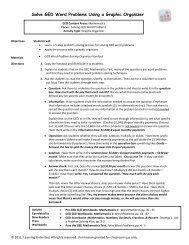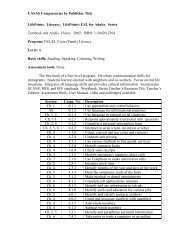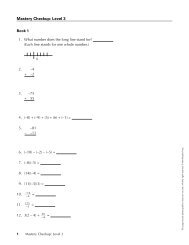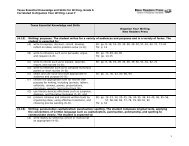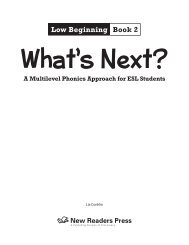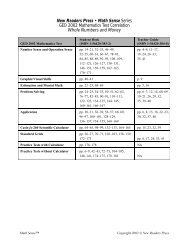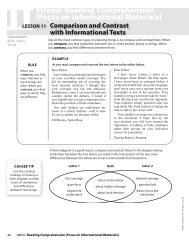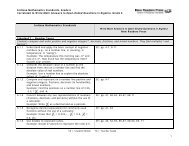News For You Voting Guide - New Readers Press
News For You Voting Guide - New Readers Press
News For You Voting Guide - New Readers Press
You also want an ePaper? Increase the reach of your titles
YUMPU automatically turns print PDFs into web optimized ePapers that Google loves.
2012<br />
VOTING GUIDE<br />
This brief voting guide comes to you from <strong><strong>New</strong>s</strong> for <strong>You</strong>, the easy-to-read<br />
weekly newspaper. The guide explains who can vote and why every vote<br />
counts. It describes how Americans choose their leaders. It also tells you how<br />
to register and how to cast your ballot.<br />
WHO VOTES<br />
Today, just about any citizen who<br />
is at least 18 years old can register to<br />
vote. But it hasn’t always been that<br />
way. When the U.S. was new, only<br />
white males could vote. In 1870, all<br />
men won the right to vote regardless<br />
of color or race. Women weren’t<br />
allowed to vote until 1920.<br />
Recent Patterns<br />
Not everyone who can vote<br />
actually votes. The last presidential<br />
election was held in 2008. In<br />
that election, about 64 percent of<br />
voting-age citizens cast ballots.<br />
The other 36 percent didn’t vote at<br />
all. In 2008, 131 million people voted<br />
— up 5 million from 2004.<br />
Most people who register to vote<br />
actually do vote, says the U.S. Census<br />
Bureau. Older people, homeowners,<br />
and married people are most likely<br />
to go to the polls. People with more<br />
schooling, good jobs, and higher<br />
incomes are also more likely than<br />
others to vote.<br />
<strong>You</strong>ng people go to the polls less<br />
often than older ones. In the 2008<br />
election, only 48.5 percent of citizens<br />
ages 18 to 24 voted.<br />
The likelihood of voting differs<br />
among racial and ethnic groups. Here<br />
are the turnout figures for the 2008<br />
elections:<br />
■ 66 percent of white non-Hispanic<br />
citizens<br />
■ 65 percent of black citizens<br />
■ 50 percent of Hispanic citizens<br />
■ 48 percent of Asian citizens<br />
Non-Voters<br />
Most states have limits on voting<br />
by felons. Felons are people who have<br />
been found guilty of serious crimes.<br />
A judge can decide a person is not<br />
mentally able to vote and bar that<br />
person from voting.<br />
Groups Once<br />
Barred From<br />
<strong>Voting</strong><br />
People in the following<br />
groups were once denied the<br />
right to vote either by a state or<br />
by the federal government. All<br />
of these groups can vote today.<br />
■ Non-whites<br />
■ Women<br />
■ People who didn’t own land<br />
■ Catholics<br />
■ Non-Christians<br />
■ People between 18 and 21<br />
■ People who couldn’t read or<br />
write<br />
■ Descendants of slaves<br />
■ American Indians<br />
NEWS FOR YOU VOTING GUIDE 800.448.8878 www.newsforyouonline.com 1
REASONS TO VOTE<br />
We may not all have wealth<br />
or power, but each person’s vote<br />
counts just as much as anyone<br />
else’s. In voting at least, we are all<br />
the same.<br />
<strong>Voting</strong> is a way to tell leaders<br />
what you care about. When you<br />
vote, you help make government<br />
work for you. The examples on the<br />
right describe ways government<br />
can affect some issues that concern<br />
most people.<br />
Government at all levels has a<br />
big effect on our lives. As voters,<br />
we share equal power in choosing<br />
leaders to represent us in government.<br />
Even if the person or measure<br />
you voted for doesn’t win, your vote<br />
is still important. It shows there is<br />
support for another point of view.<br />
Also, politicians notice who votes<br />
and who doesn’t. They know they<br />
must pay attention to the issues the<br />
voters care about.<br />
Of course, just because people<br />
have the right to vote doesn’t mean<br />
they’ll use it. Many people who could<br />
vote don’t.<br />
There are many reasons why<br />
people don’t vote. Some think<br />
their vote won’t make a difference.<br />
But many elections have shown<br />
otherwise. The 2000 election was<br />
one of the closest presidential<br />
elections in U.S. history. The<br />
Florida vote was especially close.<br />
George W. Bush finished ahead of<br />
Al Gore by just 537 votes.<br />
The graph below shows some<br />
reasons people gave for not voting in<br />
2008.<br />
Reasons to Vote<br />
■ <strong>You</strong> care about clean air and<br />
clean water. The government<br />
makes laws that can protect or<br />
hurt the environment.<br />
■ <strong>You</strong> have family members<br />
abroad who want to move<br />
to the U.S. The government<br />
makes rules about who can<br />
move here and how easy it is.<br />
■ <strong>You</strong> are in school or have<br />
children in school. <strong>You</strong> want<br />
the school to provide a really<br />
good education. Governments<br />
make rules about teacher<br />
training, programs, and testing.<br />
They decide what kinds of<br />
programs receive funding.<br />
■ <strong>You</strong> are looking for a job that<br />
offers a good wage and job<br />
security. The government<br />
steers the economy. That<br />
affects how easy it is to find a<br />
job, how much companies can<br />
pay workers, and what benefits<br />
companies must provide.<br />
Reasons Given for Not <strong>Voting</strong><br />
(Percent of registered non-voters, 2008)<br />
Too busy<br />
Illness or disability<br />
Not interested<br />
Didn’t like candidates<br />
Other reason<br />
Out of town<br />
Refused to answer, don’t know<br />
Registration problems<br />
Too much trouble<br />
<strong>For</strong>got<br />
Transportation problems<br />
Bad weather<br />
0.2<br />
2.7<br />
2.6<br />
2.6<br />
6<br />
7<br />
8.8<br />
17.5<br />
14.9<br />
13.4<br />
12.9<br />
11.3<br />
SOURCE: U.S. Census Bureau, Current Population Survey, November 2008.<br />
NEWS FOR YOU VOTING GUIDE 800.448.8878 www.newsforyouonline.com 2
WHAT WE VOTE ON<br />
Elections are about more than<br />
choosing a president. When you go<br />
to the polls on Election Day, you can<br />
vote for other leaders and perhaps<br />
ballot measures too. The choices<br />
you make can shape all levels of<br />
government.<br />
National Offices<br />
People elected to national offices<br />
serve in the federal government.<br />
All elections for national offices<br />
take place in even-numbered years.<br />
Americans elect presidents in years<br />
that can be divided by 4, for example<br />
2000, 2004, 2008, and 2012.<br />
Voters also elect members of the<br />
U.S. Senate and House of<br />
Representatives. They make laws for<br />
the country.<br />
Senators represent all the people<br />
of a state. Each state has two, so there<br />
are 100 U.S. senators.<br />
Members of the House represent the<br />
people of a district. States have many<br />
districts. States with more people<br />
have more districts. Each district has<br />
one representative in the House. There<br />
are 435 voting representatives.<br />
U.S. senators serve six-year terms.<br />
Senators aren’t all up for election at<br />
once. About a third of Senate seats<br />
are decided in any even-numbered<br />
year.<br />
U.S. representatives serve twoyear<br />
terms. All House seats are voted<br />
on in every even-numbered year.<br />
State Offices<br />
Voters choose a governor at the<br />
state level. They also choose state<br />
lawmakers. A body of lawmakers is<br />
called a legislature. State governments<br />
include other offices such as attorney<br />
general and controller.<br />
Voters elect state leaders in<br />
even-numbered years.<br />
Local Offices<br />
Voters elect local leaders too.<br />
They run smaller units within states.<br />
States can be divided into smaller<br />
units called counties, parishes, or<br />
boroughs.<br />
Governments of these units are<br />
set up differently in different states.<br />
Usually one person is elected to head<br />
the local government. There is almost<br />
always a legislature at this level as well.<br />
Counties, parishes, and boroughs<br />
are divided into even smaller units.<br />
They may be called towns, townships,<br />
cities, or villages.<br />
These smaller units of government<br />
also hold elections. Most cities elect<br />
mayors and city council members.<br />
The city council makes laws for the<br />
city.<br />
Voters also elect people to serve<br />
in special offices. These officials<br />
might steer water or sewer districts.<br />
In addition, voters elect school board<br />
members to oversee schools.<br />
At the local level, some judges are<br />
elected. Others are picked by elected<br />
leaders.<br />
Ballot Measures<br />
Besides voting for people, voters<br />
may need to decide on ballot<br />
measures, or propositions. These<br />
are proposed laws at the state or<br />
local level. They often deal with<br />
budgets and taxes. They can also<br />
deal with schools, development,<br />
crime, waste management, or<br />
anything that is important to<br />
communities. Voters choose yes<br />
to pass a measure or no to defeat it.<br />
NEWS FOR YOU VOTING GUIDE 800.448.8878 www.newsforyouonline.com 3
CHOOSING A PRESIDENT<br />
Presidential elections involve a<br />
complex process. First the political<br />
parties must select candidates. Later<br />
the candidates run against one<br />
another in the general election.<br />
The Beginning<br />
People who hope to run for<br />
president start to raise money and<br />
campaign at least a year before the<br />
general election. If a person wants<br />
to represent a political party, he or<br />
she must first be nominated by party<br />
delegates at the national convention.<br />
Primary Elections and<br />
Caucuses<br />
Delegates to the national convention<br />
are chosen through primary elections<br />
and caucuses. Every state has either a<br />
primary or a caucus system.<br />
Most states use primary systems.<br />
In primary elections, voters go to<br />
the polls and cast their ballots. They<br />
choose the person they want from<br />
among those seeking their party’s<br />
nomination.<br />
Fewer states hold caucuses. These<br />
are meetings where voters choose<br />
delegates for their party’s national<br />
convention.<br />
Primary and caucus results tell<br />
which delegates will go to the<br />
national conventions. Each contest<br />
gives candidates a certain number<br />
of delegates. Usually delegates<br />
have promised to vote for a certain<br />
candidate at the national convention.<br />
National Conventions<br />
The parties hold their national<br />
conventions in the summer before<br />
the general election. Each state sends<br />
a certain number of delegates to the<br />
convention.<br />
To be nominated by their party,<br />
a candidate must win a majority of<br />
delegates at the convention.<br />
General Elections<br />
After each party has named a<br />
candidate, the general election process<br />
begins. Candidates campaign around<br />
the country to try to win the support<br />
of voters.<br />
In November, voters decide who<br />
they want to become president.<br />
They cast their ballots on Election<br />
Day. However, the president is not<br />
chosen directly by the voters, but by<br />
the Electoral College.<br />
The Electoral College<br />
The U.S. Constitution requires<br />
that the Electoral College finally<br />
decide who will be president. The<br />
Electoral College is a group of<br />
citizens selected by the people to<br />
cast votes for president.<br />
The candidate who wins a majority<br />
of the people’s votes in each state<br />
gets all of the state’s electoral votes.<br />
In the end, the presidential candidate<br />
who gets a majority of electoral votes<br />
wins the election.<br />
The number of electors for each<br />
state is based on how many seats<br />
it has in Congress. The number is<br />
revised every 10 years. Since 2000,<br />
California has had the most electoral<br />
votes, with 55. States get no fewer<br />
than three votes. The District of<br />
Columbia has three votes.<br />
NEWS FOR YOU VOTING GUIDE 800.448.8878 www.newsforyouonline.com 4
POLITICAL PARTIES<br />
A political party is an organized<br />
group of people that controls or<br />
seeks to control a government.<br />
Parties compete against one<br />
another in elections to keep or<br />
gain power.<br />
Members of a party share some<br />
basic political goals. However,<br />
members may disagree on some<br />
issues.<br />
Major Parties<br />
The U.S. has two major political<br />
parties: the Democratic Party and the<br />
Republican Party.<br />
The Democratic Party is the oldest<br />
one. It began in 1828 when a group of<br />
people came together to try to win the<br />
presidency for Andrew Jackson.<br />
The Republican Party began in<br />
the 1850s as the party that opposed<br />
slavery.<br />
In many states, both Democrats<br />
and Republicans have strong support.<br />
In some states and regions, however,<br />
voters have usually supported one<br />
party or the other.<br />
Third Parties<br />
There have been many so-called<br />
third parties in the U.S. None of<br />
them has ever won the presidency.<br />
But many third-party proposals have<br />
gained widespread support.<br />
Some of the larger third parties<br />
are the Constitution Party, the Green<br />
Party, and the Libertarian Party.<br />
All of those parties have offices and<br />
websites where you can learn about<br />
them.<br />
Non-Party Candidates<br />
A person doesn’t have to belong to a<br />
political party to run for office. Many<br />
people have run as independents.<br />
However, running a campaign is<br />
costly. It is hard for anyone to run<br />
a successful campaign without the<br />
support of a political party.<br />
Republican Party<br />
Democratic Party<br />
Some Third Parties<br />
Constitution<br />
Party<br />
Libertarian<br />
Party<br />
Green<br />
Party<br />
GETTING INFORMED<br />
Part of your responsibility as a<br />
voter is to learn about candidates<br />
and issues before election day.<br />
That will help you decide which<br />
candidates and ballot measures to<br />
vote for or against.<br />
Some Ways to Get Informed<br />
• Watch TV and listen to the radio.<br />
Tune in for speeches, interviews,<br />
and debates.<br />
• Listen carefully to campaign ads.<br />
They might not present facts or<br />
information in a balanced way.<br />
• Read newspapers and magazines.<br />
• Listen to organizations you belong<br />
to or trust.<br />
• Talk with people you know. <strong>You</strong><br />
can help each other learn about<br />
issues and decide how to vote.<br />
Lots of information can be found<br />
on the Internet. Two sites that have<br />
basic information about a range of<br />
candidates and issues are:<br />
• Smart Voter<br />
www.smartvoter.org<br />
• Vote411.org<br />
www.vote411.org<br />
NEWS FOR YOU VOTING GUIDE 800.448.8878 www.newsforyouonline.com 5
WHAT TO WATCH FOR WHEN<br />
YOU WATCH A DEBATE<br />
How do you watch a presidential<br />
debate And how can you tell who<br />
“wins”<br />
The League of Women Voters<br />
offers a guide to watching debates.<br />
The guide is on the League’s website<br />
at www.lwv.org. The group educates<br />
citizens about government and<br />
political issues. But it does not<br />
support or oppose any candidate. The<br />
League has tips to help you prepare<br />
for, watch, and evaluate debates.<br />
Before the Debate<br />
The League urges you to prepare<br />
before watching a debate. That will<br />
help you know what to look for so<br />
you get the information you need. It<br />
is important to:<br />
■ follow the race to learn about the<br />
candidates and their backgrounds<br />
■ decide which issues are most<br />
important to you<br />
■ think about the questions you<br />
would ask and the information you<br />
need to make an informed decision<br />
■ keep an open mind about the<br />
candidates, beyond their party<br />
memberships<br />
During the Debate<br />
During the debate, the candidates<br />
answer questions from a moderator<br />
or from voters themselves. As you<br />
watch, ask yourself some questions:<br />
■ Do the questions cover issues that<br />
are important to you<br />
■ Are the questions clear and fair<br />
Are they equally tough on all<br />
candidates<br />
■ Does the format give each<br />
candidate the same chance to state<br />
his or her views<br />
■ How would you judge the work of<br />
the moderator<br />
■ Do the candidates answer<br />
questions directly Or do they give<br />
evasive answers<br />
■ Are they specific about their<br />
views Do they support their<br />
positions with facts and figures<br />
■ Do they talk about their own<br />
positions Or do they just attack<br />
the opponent<br />
■ Are their proposals realistic<br />
■ Does each candidate appear<br />
confident and relaxed<br />
■ Do they respond naturally to<br />
questions Or do their answers<br />
seem rehearsed<br />
■ Do their answers show that they<br />
have changed their positions If<br />
so, do they explain why<br />
After the Debate<br />
<strong>You</strong> may form opinions about the<br />
candidates as you watch a debate.<br />
But the League suggests that you<br />
take time to think about what you see<br />
and hear. That can help you sort your<br />
thoughts about the candidates. <strong>You</strong><br />
can do this by:<br />
■ talking with others who watched<br />
the debate<br />
■ asking yourself if you learned<br />
something new about the issues or<br />
the candidates<br />
■ finding the issues on which you<br />
agree, or disagree, with each<br />
candidate<br />
■ figuring out which questions you<br />
still have<br />
■ getting more information from<br />
the candidates’ websites or news<br />
reports<br />
■ watching later debates to see<br />
whether you still feel the same<br />
way about the candidates<br />
These steps should help you<br />
answer the question, “Which<br />
candidate is most qualified for<br />
office”<br />
NEWS FOR YOU VOTING GUIDE 800.448.8878 www.newsforyouonline.com 6
POLITICAL CAMPAIGN ADS<br />
The styles and techniques of<br />
campaign ads may change over the<br />
years. But the basic messages are<br />
still the same.<br />
<strong>You</strong> can explore political<br />
ads from the last 60<br />
years. “The Living Room<br />
Candidate” is an online exhibit of<br />
presidential campaign ads through<br />
TV history. <strong>You</strong> can find it at<br />
www.livingroomcandidate.org. The<br />
Museum of the Moving Image in<br />
Astoria, <strong>New</strong> York created it.<br />
Visitors to the exhibit can watch<br />
the ads by year. They can choose ads<br />
by issue, such as war or taxes. They<br />
can also choose types of ads they want<br />
to see. Those might include ads that<br />
feature children, or fear messages,<br />
or candidates’ life stories.<br />
There are some new techniques.<br />
<strong>For</strong> instance, many ads now use a<br />
candidate’s own words against him<br />
or her. But what really defines today’s<br />
advertising is speed.<br />
<strong>New</strong> ads may come out within<br />
hours of a news event. Many are<br />
posted instantly on the Internet<br />
before they are seen on TV. The<br />
number and speed of the ads<br />
can be overwhelming to voters.<br />
With its exhibit, the museum<br />
tries to help viewers think about<br />
how they watch ads. When they see an<br />
old trick or technique, they can look<br />
past that to the real message.<br />
They can also check the facts in<br />
an ad by reading news reports<br />
and visiting websites such as<br />
www.factcheck.org.<br />
MINING THE MESSAGE<br />
Here are some things to think<br />
about as you watch ads during the<br />
presidential campaign:<br />
What images are used<br />
Are the images light or dark Are<br />
they still or fast-paced How do they<br />
make you feel<br />
an ad may also include text to make<br />
or emphasize a point. If it is used,<br />
what does the text say What is the<br />
purpose of the text<br />
Who is sponsoring the ad<br />
Does the candidate “approve this<br />
message” Or is another group acting<br />
for the candidate If so, what is that<br />
group What is its intent<br />
Who is in the ad<br />
Does the candidate speak Or does<br />
the campaign use others—such as<br />
an opponent or actors playing “real<br />
people”<br />
What sound is used<br />
Sound—or the lack of it—is<br />
important in advertising. Is music<br />
included in the ad If so, what type<br />
How do you respond to it If voices<br />
are used, do they sound upbeat or<br />
gloomy Does the sound you hear<br />
match the message<br />
What text is used<br />
In addition to images and sound,<br />
What facts are<br />
communicated<br />
Most campaigns make claims,<br />
either about their own candidate<br />
or the opponent. But such claims<br />
may or may not be true. What<br />
information is presented as<br />
fact <strong>You</strong> can find out whether<br />
candidates’ statements are true at<br />
www.factcheck.org.<br />
NEWS FOR YOU VOTING GUIDE 800.448.8878 www.newsforyouonline.com 7
REGISTERING TO VOTE<br />
Before you can vote, you need to<br />
register. That means signing up with<br />
the government office that runs<br />
elections where you live. <strong>You</strong> give<br />
the office your name, address, and<br />
some other information.<br />
Reasons<br />
Registering allows the elections<br />
office to record which voting district<br />
you live in. Then the office can tell<br />
you where you must go to vote.<br />
Who you can vote for in state<br />
and local elections depends on your<br />
address. <strong>You</strong> can choose only<br />
candidates who are running to serve<br />
the area where you live.<br />
The system that registers voters<br />
helps keep elections fair. It makes<br />
sure a person votes only once.<br />
The elections office gives each<br />
polling place a list of registered<br />
voters. When you go to vote, a poll<br />
worker will check a list for your<br />
name.<br />
Deadlines<br />
Many of the rules for registering<br />
to vote differ around the U.S.<br />
Deadlines for registering vary from<br />
place to place. However, federal<br />
law says you can’t be required to<br />
register more than 30 days before an<br />
election.<br />
Most states require people to<br />
register 30 days before election day.<br />
Eight states allow people to register<br />
on the same day they vote. Those<br />
eight are Idaho, Iowa, Maine,<br />
Minnesota, Montana, <strong>New</strong><br />
Hampshire, Wisconsin, and<br />
Wyoming. In North Dakota, people<br />
can vote without registering.<br />
<strong>You</strong> must register to vote any<br />
time you change your address or<br />
your name. Try to register as soon as<br />
If English Isn’t <strong>You</strong>r Main Language . . .<br />
Perhaps English isn’t your main language. Don’t let that stop you from<br />
registering and voting. <strong>You</strong> might be able to get voting help in your main<br />
language.<br />
A U.S. law requires certain places to provide voting help in a language<br />
besides English. That’s true for areas where at least 10,000 people or 5 percent<br />
of voting-age people do not speak English well.<br />
The law says those citizens must be given voting help in their main language.<br />
The local government must hire poll workers who speak that language.<br />
It must provide ballots, notices, forms, instructions, and other voting<br />
materials in the language.<br />
Check with your local elections office to find out if you can get special<br />
language help. Be sure to do this well before election day!<br />
you can after the change. That will<br />
prevent rushing and problems close<br />
to an election.<br />
How to Register<br />
In most places around the U.S.<br />
there are a few ways to register. <strong>You</strong><br />
can do it in person or by mail. If you<br />
have access to the Internet, you can<br />
begin the registration process online.<br />
To register in person, go to one of<br />
the following places:<br />
• a motor vehicle office—the<br />
U.S. has a “Motor Voter” law.<br />
It says all motor vehicle offices<br />
in the country must offer voter<br />
registration forms.<br />
• the local elections office<br />
• a public aid office<br />
• a public library<br />
• a post office<br />
• other government offices<br />
To register by mail, call your local<br />
elections office. Ask them to mail you<br />
a voter registration form. Then fill it<br />
out and mail it back.<br />
To begin the registration process<br />
online, go to www.vote411.org and<br />
click on “Register to Vote.” Fill out<br />
the onscreen form. Then print out the<br />
form and mail it in. The form will tell<br />
you where to send it.<br />
Sending this form will not<br />
complete the registration process in<br />
certain states. If those states receive<br />
that form, they will send you the<br />
required state form. <strong>You</strong>’ll need to<br />
fill in the state form and mail it in to<br />
register.<br />
Choosing a Party<br />
The registration form will ask for<br />
your choice of political party. <strong>You</strong><br />
do not have to choose one. In most<br />
places, though, you must choose a<br />
party to be able to vote in that party’s<br />
primary.<br />
Picking a party does not force you<br />
to vote for its candidates. <strong>You</strong> can<br />
vote for people from other parties if<br />
you wish.<br />
Proof of Registration<br />
After you turn in your registration<br />
form, you should get a notice in the<br />
mail. It will confirm that you are on<br />
record as a registered voter. It should<br />
tell you where you can vote. The<br />
notice should arrive a few weeks after<br />
you turn in your form.<br />
NEWS FOR YOU VOTING GUIDE 800.448.8878 www.newsforyouonline.com 8
CASTING YOUR VOTE<br />
Election day comes. It’s time to<br />
make your voice heard!<br />
Polling Places<br />
On election day, people vote in<br />
different sorts of places. <strong>You</strong>r voting<br />
site might be a school, a church, a<br />
community center, a fire station, or<br />
another neighborhood building.<br />
<strong>You</strong> must go to the correct polling<br />
place. The place you go to vote will<br />
depend on where you live.<br />
There are several ways of finding<br />
out where to vote:<br />
■ <strong>You</strong> might have received a notice<br />
after you registered to vote. Check<br />
it to see if it lists the address of<br />
your polling place.<br />
■ Call your local elections office.<br />
Be aware that the office could be<br />
very busy on election day. Calling<br />
before that day could help you find<br />
out what you need to know faster.<br />
■ Ask a neighbor.<br />
■ Check a local newspaper.<br />
Find out both where and when to<br />
go. Polling places will be open only<br />
during certain hours. Usually, they<br />
open between 6 a.m. and 8 a.m. and<br />
close between 6 p.m. and 9 p.m.<br />
Arriving to Vote<br />
When you arrive at the voting site,<br />
you will need to sign in. <strong>You</strong> should<br />
see a table with poll workers near it.<br />
A poll worker will ask for your<br />
name and your address. The worker<br />
will check for your name on a list<br />
of registered voters. In most places,<br />
you will be asked to sign your name.<br />
The worker might also ask for your<br />
ID.<br />
Once you have signed in, you are<br />
ready to vote. <strong>You</strong> might want to<br />
look at a sample ballot before voting.<br />
If you do not see a sample ballot on<br />
display, ask for one.<br />
A sample ballot looks just like the<br />
real ballot you will use when you<br />
vote. The sample lists the candidates.<br />
It presents any ballot measures that<br />
voters will be deciding on.<br />
Reading the sample ballot can<br />
help the voting process go smoothly<br />
for you. <strong>You</strong> might feel less rushed<br />
when you use the voting device.<br />
<strong>You</strong> won’t have to worry that you’re<br />
taking too long and holding other<br />
people up.<br />
What <strong>You</strong>’ll Need<br />
Many states require voters to<br />
show an ID at the polling place.<br />
Even if your state doesn’t require<br />
an ID, bringing one can be helpful.<br />
Poll workers might ask to see it to<br />
check your address.<br />
<strong>Voting</strong> by Mail<br />
Even if you will be away from<br />
home on election day, you can still<br />
vote. <strong>You</strong> will have to mail in a<br />
paper ballot. In many places, this<br />
piece of paper is called an absentee<br />
ballot.<br />
If you want to vote by mail, you<br />
must contact your local elections<br />
office. <strong>You</strong> should do so at least<br />
45 days before the election.<br />
The office will send you a ballot in<br />
the mail.<br />
Most states require voters’ mail-in<br />
ballots to be received by the end of<br />
election day. <strong>You</strong> must make sure you<br />
mail your ballot early enough.<br />
Many states let people vote by<br />
mail for any reason. Someone might<br />
choose to vote by mail just to avoid a<br />
trip to the polling place.<br />
Other states require people to have<br />
a good reason for voting by mail.<br />
The voters must tell why they will be<br />
unable to go to the polling place.<br />
NEWS FOR YOU VOTING GUIDE 800.448.8878 www.newsforyouonline.com 9
USING VOTING EQUIPMENT<br />
When it’s your turn to vote, you<br />
will go to a private area. Unless you<br />
tell someone, no one but you has to<br />
know how you voted.<br />
The equipment used for voting<br />
differs from place to place.<br />
Poll workers can show you how a<br />
device works. Feel free to ask them<br />
for help.<br />
If you have a question or problem<br />
while using the voting device,<br />
signal a poll worker. Wave or call<br />
for one to come over. <strong>You</strong> deserve to<br />
have your vote recorded and counted<br />
correctly.<br />
In recent years, five main types<br />
of equipment have been used by<br />
U.S. voters. A list of those five and<br />
an explanation of how they work is at<br />
right. Most states use one or more of<br />
the first three types.<br />
Optical scan systems. A poll worker will give you<br />
cards or sheets of paper. Each piece has candidate<br />
names and ballot measures printed on it.<br />
Take the cards over to a private table. Fill in the box<br />
or circle next to the candidate you want or your ballot<br />
measure choice. <strong>You</strong> will use a pen or pencil to make<br />
your marks.<br />
When you have finished, you must either give the<br />
cards to a poll worker or feed the cards into a machine.<br />
Later, a computer will count the votes.<br />
Direct recording electronic systems. More and more<br />
sites are getting direct recording electronic systems<br />
for voting. Different forms of these systems exist.<br />
Usually, a poll worker will give you a card that slides<br />
into a device. A computer screen will display possible<br />
choices for voters on some form of computer screen.<br />
Voters make choices in different ways depending<br />
on the type of system. In many cases, you touch part<br />
of the screen. In other cases, you might push buttons<br />
on a keypad. These systems work something like the<br />
ATMs used for banking.<br />
Paper ballots. If you vote by mail, you will use a<br />
paper ballot. A few places still use paper ballots at<br />
the polls. A poll worker will give you a piece of<br />
paper. <strong>You</strong> will take it to a private area. Then you<br />
will use a pencil or pen to mark a box next to<br />
the candidate’s name or ballot-measure choice.<br />
When you are finished, drop the paper ballot into<br />
a ballot box.<br />
Mechanical lever machines. A few states still use<br />
these machines. When it’s your turn to vote, you will<br />
step into a voting booth. Start the voting process by<br />
pulling a large lever that closes a curtain.<br />
Inside you will see a list of candidates’ names and<br />
ballot measure choices. Next to each listing is a small<br />
lever. To cast a vote, you turn the lever.<br />
When you have finished making all your choices, pull<br />
the lever that opens the curtain. When you pull it, the<br />
machine records your votes and resets the small levers.<br />
© <strong>New</strong> <strong>Readers</strong> <strong>Press</strong>. Published as a supplement to<br />
<strong><strong>New</strong>s</strong> for <strong>You</strong> by <strong>New</strong> <strong>Readers</strong> <strong>Press</strong>, a publishing division<br />
of ProLiteracy, a nonprofit educational corporation,<br />
1320 Jamesville Ave., Syracuse, NY 13210. <strong><strong>New</strong>s</strong> for <strong>You</strong> is<br />
published every week except the week of Thanksgiving,<br />
the week before Christmas, the week of Christmas, and<br />
the week after Christmas by <strong>New</strong> <strong>Readers</strong> <strong>Press</strong>, 1320<br />
Jamesville Ave., Syracuse, <strong>New</strong> York 13210. Classroom<br />
subscription rate is $.38 per copy. Single subscription<br />
rates: 24 weeks: $27.00; 48 weeks: $42.00. All subscriptions<br />
payable in advance. Periodical postage paid at Syracuse,<br />
<strong>New</strong> York. Postmaster: send address changes to<br />
<strong>New</strong> <strong>Readers</strong> <strong>Press</strong>, 1320 Jamesville Ave., Syracuse,<br />
<strong>New</strong> York 13210.<br />
Punchcard systems. Only a few places use these<br />
systems now. A poll worker will give you one or more<br />
cards. Each card will have small rectangles that can be<br />
punched out.<br />
<strong>You</strong> will bring the cards to a table. There you will<br />
find a booklet on a frame. Slide the first card into the<br />
frame. Make sure you put it in all the way and line it up<br />
correctly.<br />
<strong>You</strong> will see a small punch device at the table. Use it<br />
to punch holes in the cards next to a candidate’s name<br />
or ballot measure choice.<br />
NEWS FOR YOU VOTING GUIDE 800.448.8878 www.newsforyouonline.com 10




